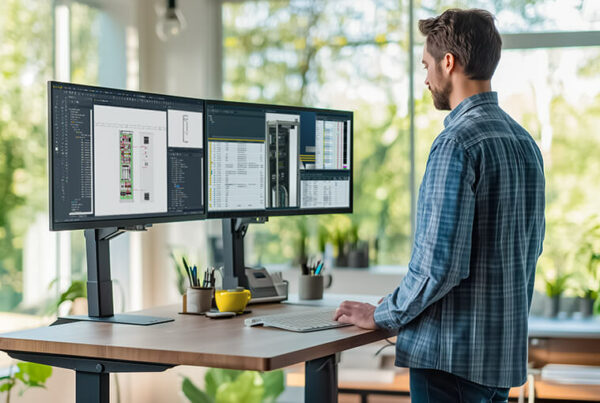
You thought LinkedIn is only for sales people, influencers and job seekers? Not by a long shot! LinkedIn is the world’s largest business platform, career network and job board in one!
Especially business partners and potential clients often look at LinkedIn profiles of companies and their employees in advance to decide whether they want to do business with them. Therefore, a professional online appearance for employees is essential on social media platforms. With a convincing LinkedIn profile, you prove customers and business partners that you have dealt with current topics and innovations, you show competence and build trust. But don’t worry, you don’t have to start posting five times a week. In this blog post, we’ll show you how to optimize your LinkedIn profile as an Electrical Engineer and what to look out for.
Tips on how to optimize your LinkedIn profile as an Electrical Engineer
1. Upload a profile photo
On average LinkedIn profiles with a picture are clicked on 14 times more often. An up-to-date profile photo is therefore the easiest and first way to optimize your LinkedIn. Portrait photos that look professional but not too stiff are best. Make sure that the photos are well exposed and have a high resolution – you want to attract potential customers or employers with your profile and not discourage them with an outdated, pixelated picture.
2. Personalize the header
Did you know that you can also personalize the header of your LinkedIn profile? Instead of the default blue background, you can display photos, logos or messages visibly right at the beginning. This is how you make your profile stand out from the rest. You don’t have to be a graphics expert to do this. Just upload a picture or use one of our free LinkedIn headers for Electrical Engineers.




We offer you five LinkedIn header graphics for Electrical Engineers in English, German or without text – free to download at wscad.com/en/downloads.
3. Profile header – show more than just your job title
The area below your profile picture plays a crucial role, as it acts as the header for your entire profile. Here you can state your profession or title and give a first impression of the electrical engineering expertise and added value you can offer. To use this effectively and stand out from other profiles, you should answer two important questions: What is your specific expertise related to electrical engineering and how can you help customers, partners, or companies with their projects? So instead of simply writing “Electrical Engineer” or “Electrical Designer,” you could phrase it
This shows directly that you have in-depth knowledge in certain areas of electrical engineering and points out how you can help other players in the industry.
4. Make good use of your LinkedIn activities
Did you know that other users can view your latest comments, posts and interactions on LinkedIn?
Although at first glance you might feel a bit uncomfortable, this feature provides an opportunity to position yourself strategically. By regularly commenting on or sharing interesting posts, you can demonstrate your expertise beyond your resume. Of course, you should always treat other users with respect when making posts or commenting. So go ahead and use LinkedIn activities to your advantage!
5. Show your personality
Through your LinkedIn bio, other users gain insight into your personality, experience and skills. We recommend that you write your bio as if you were introducing yourself in person at an event, and of course, the bio can also be used strategically. If you’re an Electrical Engineer that works on many projects, your LinkedIn bio is an ideal opportunity to give partners and companies a first impression of how you work and how you succeeded in the past.
Please make sure that you don’t simply replicate your resume – that will come in the next step. The key here is to convince the reader in a few sentences who you are, what sets you apart, and if desired, what your goals or expectations are (i.e. to create a network, find customers, etc). Using relevant keywords increases your chances to be found in search queries. For example, are you working with the electrical CAD software WSCAD ELECTRIX? Or are you an expert in the standardization of product groups? By specifically mentioning such terms, you increase your chances to be found within the LinkedIn network. An example of an appealing LinkedIn bio could look like this:
6. Go into detail with your resume
Your LinkedIn resume shows your previous work experience. In another section, you can set your educational history. “Don’t consider your resume as a list of previous job titles. Instead, summarize your role in each position in a few sentences and list at least three tasks you performed in that role.”
For example
Example companyJuly 2019 – TodayAs a Project Manager, I support companies in electrical engineering, industrial automation, and control panel design with special equipment design and process automation.My tasks include among others
– preparation of quotations
– Project management and specification of technical requirements
– Design of electrical schematics, cable lists, parts lists and control cabinet layouts with the electrical CAD software WSCAD ELECTRIX
7. Certificates and credentials
Below the work experience section, users have the option to upload their certificates and credentials. These include trainings and workshops or any other skills you have acquired. Have you attended a WSCAD training? Simply upload the certificate. Did you know that you can take many free courses at LinkedIn Learning on topics such as project management, Excel, but also on electrical engineering? After successful completion, you can also add these LinkedIn certificates to your profile.
8. Ask the people in your network for a recommendation
Did you know that you can include recommendations from colleagues and partners in your profile? References are a great opportunity to credibly demonstrate your expertise.
To ask for a recommendation, follow these steps:
- Identify the people in your network with whom you have worked successfully and who have good insight into your skills and accomplishments. For example: former supervisors, teammates, or long-time clients.
- Think about what aspects of your work that person could talk about or emphasize. You could ask someone to confirm your expertise in panel building or your innovation power in introducing new technologies.
- Send these individuals a personal message via LinkedIn or email explaining why you are asking them for a recommendation. Show appreciation for their opinion and emphasize how important their feedback is to your professional development.
- It is a good idea to first write a recommendation yourself for the other person you would like a reference from.
Conclusion: Your way to a successful profile on LinkedIn
A well-maintained LinkedIn profile can be a real door opener for your career or future business relationships. Now that you have successfully optimized your LinkedIn profile, it’s time to get to networking! Share your experiences and learn from other industry professionals. In a next blog post, we’ll show you what options you have to expand your network on LinkedIn and establish valuable contacts. Stay tuned and take advantage of the opportunities offered by the largest online professional network.
Oh yes: and why not visit WSCAD on LinkedIn and subscribe to our channel 🙂


